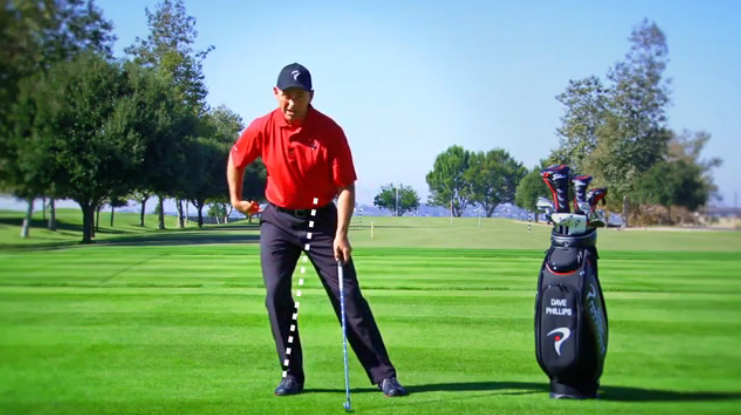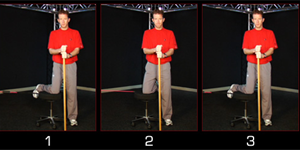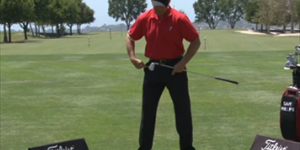IMPROVE MY GAME
Articles
Eliminate the Sway

Eliminating the Sway
The “Sway” swing fault refers to any excessive lateral motion of the lower body away form the target on the backswing. This can lead to reduced lower body speed, poor trunk stability, and limited power in the golf swing. I have found that placing the player on a lower body stabilization / mobilization program is one of the fastest ways to clean up this swing breakdown. The following is my guideline for attacking this swing fault in the gym.
Establish ankle pronation:
One of the most common causes of excessive sway is limited ankle pronation. In other words, if a player does not have the ability to evert or pronate his trail side ankle, they usually have difficulty keeping their weight on the inside portion of their back foot on the backswing. If the player actually supinates the back foot, this will absolutely create the sway. So if you have a player who if flat footed and is already hyperpronated, the only thing their foot can do is supinate. Therefore, they usually supinate on the backswing and start to sway. On the other hand, if the player has reduced ankle range of motion (like players with excessively high arches – rigid foot) they might also have difficulty keeping the weight on the inside of their trail foot.
I suggest that all players who sway in their backswings, be placed on an ankle range of motion and stabilization routine. Make sure you re-establish normal range of motion in the ankle and obtain proper control of the intrinsic foot musculature early in their program. Try the Flatten Arches Form Arches and the Wobble Board drills listed below.
Establish proper gluteal stability:
Now that the ankle is functioning properly, we need to provide a strong stable lower body platform to create rotation around. In my mind, that always begins and ends with the glutes (buns of steel). Make sure you address both parts of the glutes; the glute max and glute medius since they both help stabilize the lower body from excessive lateral motion.
I always start my players with isolation drills of the glute max fist and then progress to the glute medius second. Due to over-activation of the hamstrings and lower back muscles and inhibition of the glute max, many players are unable to simply contract the glute max by itself. For this reason, I have my players get into a supine position and practice contracting their glute max without simultaneous contraction of the hamstring or lower back. You must break this neurological reflex before progressing to advanced glute strengthening exercises or the player will get a great leg workout instead of a great butt workout.
Once they can fire the glute max in isolation I like to use the bridge and bird dog exercises to build glute max strength and stability. After a few sessions I slowly add in the squat and lunge progressions followed by the deadlift.
For the glute medius, I like to wake the muscle up first and then hit it hard until it burns. I use side steps or duck walks (x-walks) to show the player where the muscle is located. It is hard to not fire the glute medius during those exercises. Once the player can feel where the muscle is and what it feels like to contract, I get them in a side-lying position and start with side leg lifts and the side plank/bridge progressions. The side leg lift is one of the best exercises for increasing the strength in the glute medius if done correctly. I want to emphasize that this exercise is hard to do correctly. Most players want to drop their pelvis back and recruit their TFL and QL for lack of strength in the glute medius. Make sure the player keeps their hips perpendicular to the floor and their top leg from shifting anterior during the lift.
Establish proper hip range of motion:
The next area to focus on for eliminating the sway is proper hip range of motion. Research has shown that good trail side hip internal rotation (>45 degrees) can dramatically reduce the incidence of sway in the golf swing, plus it can reduce stress to the lower back. For this reason, all my golfers who sway are put on a hip rotational program. That program consists of three basic exercises: hip joint warm up, hip internal rotation, and closed chain – standing hip internal rotation.
Hip Joint Warm-Ups include: Hip Drops, Leg Overs, Figure 4 Stretches, and Hip Circles.
Hip Internal Rotation Exercises include: Hip Windshield Wipers supine and kneeling
Closed Chain Rotational Drills include: Side Step Ups, Shovel Pass, and Torso Backswing
Create good core separation:
The last area to add to your “eliminate the sway” program is good mobility between the upper and lower body. Players with limited “X-Factors” tend to have excessive lateral motion due to limited rotary motion. I like to attack thoracic spine rotation and couple this with good lower body stability. Some of my favorite exercises that help attack thoracic spine rotation are the following: Open Books Rib Cage, Reach Backs, and Open Books Arm Bent. Some of my favorite exercises that help build lower body stability with upper body rotation are the following: Horizontal Chops, Torso Backswing Neutral Pelvis, Long Turns Half Kneeling, Chops and Lifts w/Rotation Half Kneeling and in Lunge Stance.
I think if you add these exercises to your clients program, their sway will be a thing of the past. Good luck!


